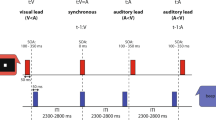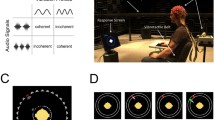Abstract
Temporal structure is ubiquitous in sensory signals, and the brain has been shown to robustly represent information about temporal structure in the phase of low frequency neural oscillations. In a related construct, the integration of information across the different senses has been proposed to be at least partly due to the phase resetting of these low frequency oscillations. As a consequence, oscillations represent a potential contributor to the encoding of complex multisensory signals with informative temporal structures. Here we investigated these interactions using electroencephalography (EEG). We entrained low frequency (3 Hz) delta oscillations using a repetitive auditory stimulus—broadband amplitude modulated noise. Following entrainment, we presented auditory and audiovisual stimuli at variable delays. We examined whether the power of oscillations at the entrained frequency was dependent on the delay (and thus, potentially, phase) at which subsequent stimulation was delivered, and whether this relationship was different for subsequent multisensory (i.e., audiovisual) stimuli when compared with auditory stimuli alone. Our findings demonstrate that, when the subsequent stimuli are solely auditory, the power of oscillations at the entrained frequency is rhythmically modulated by when the stimulus was delivered. For audiovisual stimuli, however, no such dependency is present, yielding consistent power modulations. These effects indicate that reciprocal oscillatory mechanisms may be involved in the continuous encoding of complex temporally structured multisensory inputs such as speech.







Similar content being viewed by others
References
Berens P (2009) CircStat: a MATLAB toolbox for circular statistics. J Stat Softw 31(10):1–21
Besle J, Schevon CA, Mehta AD, Lakatos P, Goodman RR, McKhann GM, Emerson RG, Schroeder CE (2011) Tuning of the human neocortex to the temporal dynamics of attended events. J Neurosci 31(9):3176–3185
Breska A, Deouell LY (2016) When synchronizing to rhythms is not a good thing: modulations of preparatory and post-target neural activity when shifting attention away from on-beat times of a distracting rhythm. J Neurosci 36(27):7154–7166
Chakravarthi R, Vanrullen R (2012) Conscious updating is a rhythmic process. Proc Natl Acad Sci USA 109(26):10599–10604
Chandrasekaran C, Trubanova A, Stillittano S, Caplier A, Ghazanfar AA (2009) The natural statistics of audiovisual speech. PLoS Comput Biol 5(7):e1000436
Crosse MJ, Butler JS, Lalor EC (2015) Congruent visual speech enhances cortical entrainment to continuous auditory speech in noise-free conditions. J Neurosci 35(42):14195–14204
Delorme A, Makeig S (2004) EEGLAB: an open source toolbox for analysis of single-trial EEG dynamics including independent component analysis. J Neurosci Methods 134(1):9–21
Ding N, Simon JZ (2013a) Adaptive temporal encoding leads to a background-insensitive cortical representation of speech. J Neurosci 33(13):5728–5735
Ding N, Simon JZ (2013b) Power and phase properties of oscillatory neural responses in the presence of background activity. J Comput Neurosci 34(2):337–343
Ding N, Simon JZ (2013c) Robust cortical encoding of slow temporal modulations of speech. Adv Exp Med Biol 787:373–381
Giraud AL, Poeppel D (2012) Cortical oscillations and speech processing: emerging computational principles and operations. Nat Neurosci 15(4):511–517
Henry MJ, Obleser J (2012) Frequency modulation entrains slow neural oscillations and optimizes human listening behavior. Proc Natl Acad Sci USA 109(49):20095–20100
Henry MJ, Obleser J (2013) Dissociable neural response signatures for slow amplitude and frequency modulation in human auditory cortex. PLoS ONE 8(10):e78758
Henry MJ, Herrmann B, Obleser J (2014) Entrained neural oscillations in multiple frequency bands comodulate behavior. Proc Natl Acad Sci USA 111(41):14935–14940
Herrmann B, Henry MJ, Haegens S, Obleser J (2016) Temporal expectations and neural amplitude fluctuations in auditory cortex interactively influence perception. Neuroimage 124(Pt A):487–497
Hickok G, Farahbod H, Saberi K (2015) The rhythm of perception: entrainment to acoustic rhythms induces subsequent perceptual oscillation. Psychol Sci 26(7):1006–1013
Howard MF, Poeppel D (2010) Discrimination of speech stimuli based on neuronal response phase patterns depends on acoustics but not comprehension. J Neurophysiol 104(5):2500–2511
Hutcheon B, Yarom Y (2000) Resonance, oscillation and the intrinsic frequency preferences of neurons. Trends Neurosci 23(5):216–222
Jung TP, Makeig S, Humphries C, Lee TW, McKeown MJ, Iragui V, Sejnowski TJ (2000) Removing electroencephalographic artifacts by blind source separation. Psychophysiology 37(2):163–178
Kosem A, Gramfort A, van Wassenhove V (2014) Encoding of event timing in the phase of neural oscillations. Neuroimage 92:274–284
Lachaux JP, Rodriguez E, Martinerie J, Varela FJ (1999) Measuring phase synchrony in brain signals. Hum Brain Mapp 8(4):194–208
Lakatos P, Shah AS, Knuth KH, Ulbert I, Karmos G, Schroeder CE (2005) An oscillatory hierarchy controlling neuronal excitability and stimulus processing in the auditory cortex. J Neurophysiol 94(3):1904–1911
Lakatos P, Chen CM, O’Connell MN, Mills A, Schroeder CE (2007) Neuronal oscillations and multisensory interaction in primary auditory cortex. Neuron 53(2):279–292
Lakatos P, Karmos G, Mehta AD, Ulbert I, Schroeder CE (2008) Entrainment of neuronal oscillations as a mechanism of attentional selection. Science 320(5872):110–113
Lakatos P, O’Connell MN, Barczak A, Mills A, Javitt DC, Schroeder CE (2009) The leading sense: supramodal control of neurophysiological context by attention. Neuron 64(3):419–430
Lakatos P, Musacchia G, O’Connel MN, Falchier AY, Javitt DC, Schroeder CE (2013) The spectrotemporal filter mechanism of auditory selective attention. Neuron 77(4):750–761
Lalor EC, Foxe JJ (2010) Neural responses to uninterrupted natural speech can be extracted with precise temporal resolution. Eur J Neurosci 31(1):189–193
Lenz D, Schadow J, Thaerig S, Busch NA, Herrmann CS (2007) What’s that sound? Matches with auditory long-term memory induce gamma activity in human EEG. Int J Psychophysiol 64(1):31–38
Luo H, Liu Z, Poeppel D (2010) Auditory cortex tracks both auditory and visual stimulus dynamics using low-frequency neuronal phase modulation. PLoS Biol 8(8):e1000445
Makeig S, Debener S, Onton J, Delorme A (2004) Mining event-related brain dynamics. Trends Cogn Sci 8(5):204–210
Murray MM, Wallce MT (2012) The neural bases of multisensory processes. Boca Raton, CRC Press
Ng BS, Schroeder T, Kayser C (2012) A precluding but not ensuring role of entrained low-frequency oscillations for auditory perception. J Neurosci 32(35):12268–12276
Obleser J, Herrmann B, Henry MJ (2012) Neural oscillations in speech: don’t be enslaved by the envelope. Front Hum Neurosci 6:250
Park H, Kayser C, Thut G, Gross J (2016) Lip movements entrain the observers’ low-frequency brain oscillations to facilitate speech intelligibility. Elife 5:e14521
Perrin F, Pernier J, Bertrand O, Giard MH, Echallier JF (1987) Mapping of scalp potentials by surface spline interpolation. Electroencephalogr Clin Neurophysiol 66(1):75–81
Picton TW, John MS, Dimitrijevic A, Purcell D (2003) Human auditory steady-state responses. Int J Audiol 42(4):177–219
Romei V, Gross J, Thut G (2012) Sounds reset rhythms of visual cortex and corresponding human visual perception. Curr Biol 22(9):807–813
Ross LA, Saint-Amour D, Leavitt VM, Javitt DC, Foxe JJ (2007) Do you see what I am saying? Exploring visual enhancement of speech comprehension in noisy environment. Cereb Cortex 17(5):1147–1153
Schmolesky MT, Wang Y, Hanes DP, Thompson KG, Leutgeb S, Schall JD, Leventhal AG (1998) Signal timing across the macaque visual system. J Neurophysiol 79(6):3272–3278
Schroeder CE, Lakatos P (2009) Low-frequency neuronal oscillations as instruments of sensory selection. Trends Neurosci 32(1):9–18
Schroeder CE, Lakatos P, Kajikawa Y, Partan S, Puce A (2008) Neuronal oscillations and visual amplification of speech. Trends Cogn Sci 12(3):106–113
Spaak E, de Lange FP, Jensen O (2014) Local entrainment of alpha oscillations by visual stimuli causes cyclic modulation of perception. J Neurosci 34(10):3536–3544
Sumby WH, Pollack I (1954) Visual contribution to speech intelligibility in noise. J Acoust Soc Am 26(2):212–215
Summerfield Q (1992) Lipreading and audio-visual speech perception. Philos Trans R Soc Lond B Biol Sci 335(1273):71–78
Ten Oever S, Sack AT (2015) Oscillatory phase shapes syllable perception. Proc Natl Acad Sci USA 112(52):15833–15837
Ten Oever S, Sack AT, Wheat KL, Bien N, van Atteveldt N (2013) Audio-visual onset differences are used to determine syllable identity for ambiguous audio-visual stimulus pairs. Front Psychol 4:331
Thorne JD, De Vos M, Viola FC, Debener S (2011) Cross-modal phase reset predicts auditory task performance in humans. J Neurosci 31(10):3853–3861
van Atteveldt N, Murray MM, Thut G, Schroeder CE (2014) Multisensory integration: flexible use of general operations. Neuron 81(6):1240–1253
Zion Golumbic E, Cogan GB, Schroeder CE, Poeppel D (2013a) Visual input enhances selective speech envelope tracking in auditory cortex at a “cocktail party”. J Neurosci 33(4):1417–1426
Zion Golumbic EM, Ding N, Bickel S, Lakatos P, Schevon CA, McKhann GM, Goodman RR, Emerson R, Mehta AD, Simon JZ, Poeppel D, Schroeder CE (2013b) Mechanisms underlying selective neuronal tracking of attended speech at a “cocktail party”. Neuron 77(5):980–991
Zoefel B, Heil P (2013) Detection of near-threshold sounds is independent of EEG phase in common frequency bands. Front Psychol 4:262
Acknowledgements
Support for this work was provided by NIH DC010927, NIH CA183492, NIH HD83211, and by the Wallace Foundation. The authors declare that they have no conflict of interest.
Author information
Authors and Affiliations
Corresponding author
Ethics declarations
Ethical Approval
All procedures performed in studies involving human participants were in accordance with the ethical standards of the institutional and/or national research committee and with the 1964 Helsinki declaration and its later amendments or comparable ethical standards.
Rights and permissions
About this article
Cite this article
Simon, D.M., Wallace, M.T. Rhythmic Modulation of Entrained Auditory Oscillations by Visual Inputs. Brain Topogr 30, 565–578 (2017). https://doi.org/10.1007/s10548-017-0560-4
Received:
Accepted:
Published:
Issue Date:
DOI: https://doi.org/10.1007/s10548-017-0560-4




